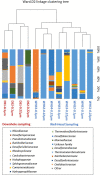A deep continental aquifer downhole sampler for microbiological studies
- PMID: 36687568
- PMCID: PMC9846368
- DOI: 10.3389/fmicb.2022.1012400
A deep continental aquifer downhole sampler for microbiological studies
Abstract
To be effective, microbiological studies of deep aquifers must be free from surface microbial contaminants and from infrastructures allowing access to formation water (wellheads, well completions). Many microbiological studies are based on water samples obtained after rinsing a well without guaranteeing the absence of contaminants from the biofilm development in the pipes. The protocol described in this paper presents the adaptation, preparation, sterilization and deployment of a commercial downhole sampler (PDSshort, Leutert, Germany) for the microbiological studying of deep aquifers. The ATEX sampler (i.e., explosive atmospheres) can be deployed for geological gas storage (methane, hydrogen). To validate our procedure and confirm the need to use such a device, cell counting and bacterial taxonomic diversity based on high-throughput sequencing for different water samples taken at the wellhead or at depth using the downhole sampler were compared and discussed. The results show that even after extensive rinsing (7 bore volumes), the water collected at the wellhead was not free of microbial contaminants, as shown by beta-diversity analysis. The downhole sampler procedure was the only way to ensure the purity of the formation water samples from the microbiological point of view. In addition, the downhole sampler allowed the formation water and the autochthonous microbial community to be maintained at in situ pressure for laboratory analysis. The prevention of the contamination of the sample and the preservation of its representativeness are key to guaranteeing the best interpretations and understanding of the functioning of the deep biosphere.
Keywords: ATEX; UGS; deep aquifer; downhole sampler; geological storage; microorganisms.
Copyright © 2023 Ranchou-Peyruse, Guignard, Haddad, Robin, Boesch, Lanot, Carrier, Dequidt, Chiquet, Caumette, Cézac and Ranchou-Peyruse.
Conflict of interest statement
DD is employed by STORENGY – Geosciences Department. PCh and GC are employed by Teréga. SR, FB, and ML are employed by Modis. The remaining authors declare that the research was conducted in the absence of any commercial or financial relationships that could be construed as a potential conflict of interest.
Figures




References
-
- Anttila P., Ahokas H., Front K., Hinkkanen H., Johansson E., Paulamäki S., et al. . (1999). Final disposal of spent nuclear fuel in Finnish bedrock – Olkiluoto site report. Posiva Technical Reprot 99-10, Posiva: Rauma, Finland.
-
- Banks E. W., Hatch M., Smith S., Underschultz J., Lamontagne S., Suckow A., et al. . (2019). Multi-tracer and hydrogeophysical investigation of the hydraulic connectivity between coal seam gas formations, shallow groundwater and stream network in a faulted sedimentary basin. J. Hydrol. 578:124132. doi: 10.1016/j.jhydrol.2019.124132 - DOI
LinkOut - more resources
Full Text Sources

